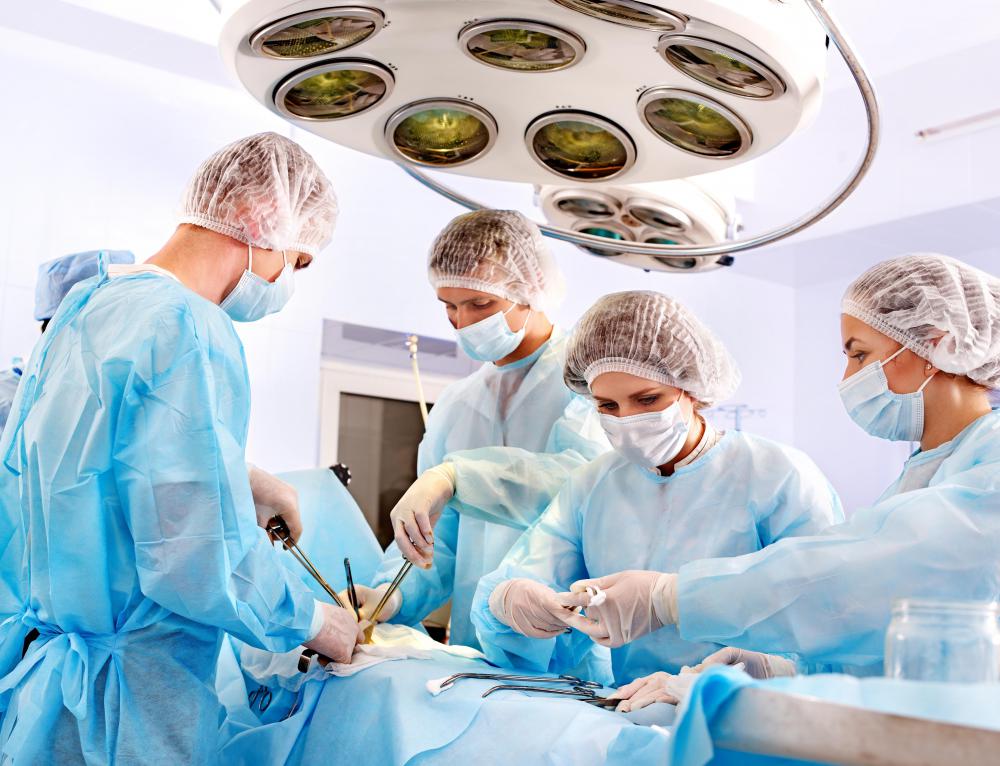At WiseGEEK, we're committed to delivering accurate, trustworthy information. Our expert-authored content is rigorously fact-checked and sourced from credible authorities. Discover how we uphold the highest standards in providing you with reliable knowledge.
What are the Different Types of Craniofacial Surgery?
Craniofacial surgery corrects acquired or congenital deformities of the face and skull, with the exception of the brain and eyes. A deformity occurs when a body part departs from the norm in size or shape. A deformity of the face or skull may be congenital, or present at birth, or acquired due to environmental factors, trauma, or disease. Sometimes, the disfigurement can be attributed to a genetic mutation, but oftentimes the cause remains unknown. Craniofacial surgery is under the umbrella of plastic surgery, which reconstructs body tissues, either for therapeutic or cosmetic reasons.
Craniofacial surgery may deal with several types of tissue in an operation, including skin, muscle, bone, teeth, and connective tissue. To perform such a procedure, surgeons should have special qualifications, including training in neurosurgery, plastic surgery, ear, nose and throat (ENT) surgery, and maxillofacial surgery. It is standard practice, however, that several specialists combine forces to treat all facets of a craniofacial abnormality. It is also customary that an anesthetist and a team of nurses are present during the surgery.

In the past, such procedures were broken into many operations, sending a patient to a different specialist to separately operate on different tissues or areas of the skull or face. This practice often led to poor results, including high mortality. Today, doctors prefer to combine procedures so that the patient undergoes as few surgeries as possible, which has greatly improved the success of craniofacial surgery. These procedures, however, are still a serious undertaking, especially for children, and often require a considerable amount of time and cause significant blood loss.

Common types of craniofacial deformities include craniosyntosis, cleft palate and lip, Miller syndrome, facial cleft, facial palsy, hemangioma, frontonasal dysplasia, and Pierre Robin syndrome. Craniosyntosis occurs when the sutures, or the breaks between the bones of the skull, fuse together prematurely in infancy. This condition results in symptoms that may include wide-set, protruding eyes, a flattened nose, abnormal foreheads, webbed toes and fingers, protruding or back-set jaw, and sagging eyelids. Treatment with craniofacial surgery will vary based on which symptoms a patient presents.
For unknown reasons, cleft lips and cleft palates sometimes occur in early development. A cleft lip may appear as a slight rift in the upper lip or a complete separation of the lip that extends to the nose. A cleft palate is when there is a separation in the roof of the mouth. Cleft palates are one sign of Pierre Robin syndrome, which also presents with abnormally small lower jaws, retracted tongues, and blocked upper airways. The cause for Pierre Robin syndrome is also unknown, but believed to be associated with a problem in fetal jawbone development.
Several types of craniofacial surgery may be combined or performed separately to treat a deformity. Distraction osteogenesis (DO), also called mandibular distraction, surgically enlarges an abnormally small lower jawbone. Naopharyngeal cannulation is a preferred method of helping babies to breathe with blocked airways, as it is less invasive. In this procedure, a breathing tube is pushed into the nose and down the throat to keep the airway open until the child’s jaws develop further.
To repair a cleft lip, a surgeon makes an incision on both sides of the cleft and then joins the lip together, taking care to ensure normal lip appearance and muscle function. Cleft palate repair requires a maxillofacial surgeon who makes an incision in the roof of the mouth and restructures the muscle and bone tissue to create a normal palate. If a child has a misshapen skull, doctors may recommend a painless remolding band or helmet to help the child’s head to develop more normally. This is particularly effective in the first six months after birth.
AS FEATURED ON:
AS FEATURED ON:












Discuss this Article
Post your comments